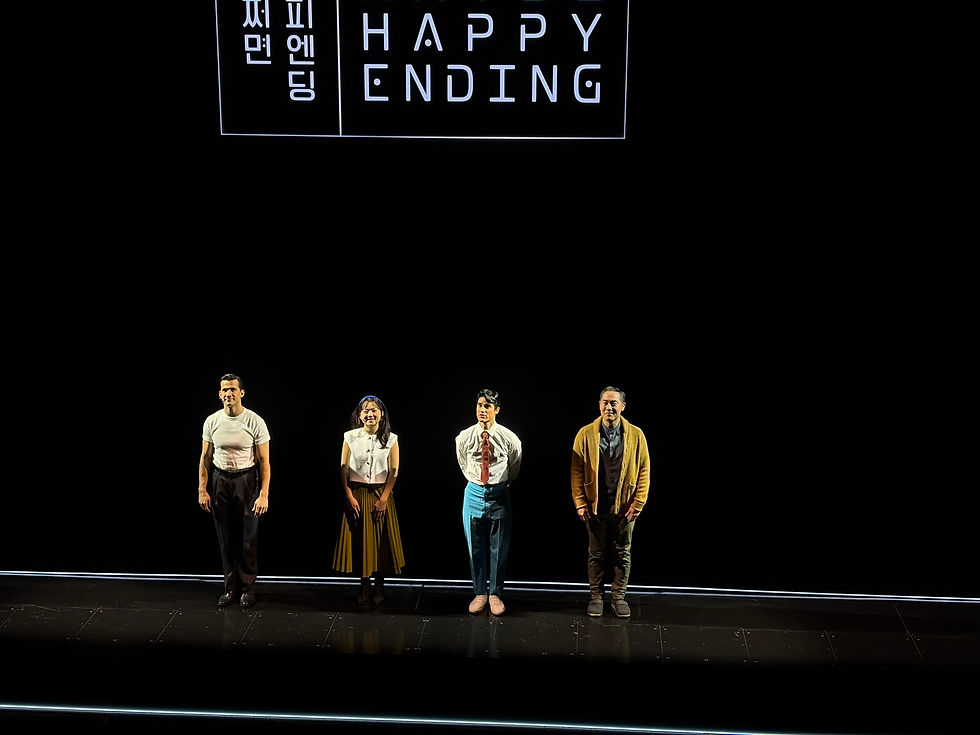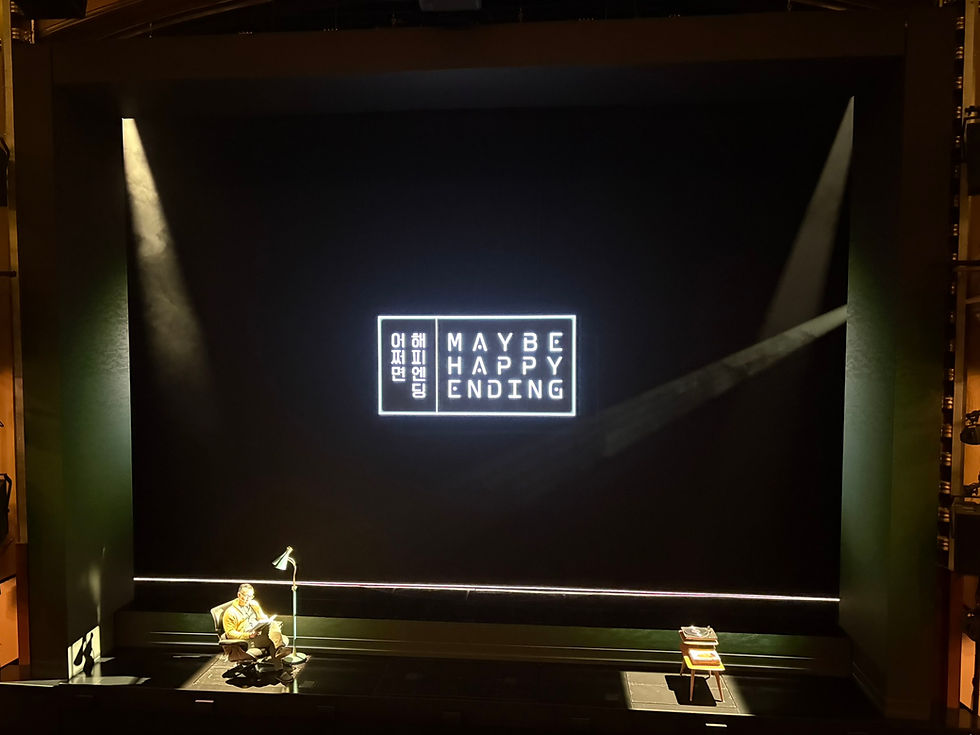Review: Maybe Happy Ending
- The Verdict

- Jun 26
- 4 min read
Updated: Nov 14
“Why love?” is the question that bookends Maybe Happy Ending, and is the driving emotional force of the show. In what was one of the most crowded seasons in the history of new musicals opening on Broadway, Maybe Happy Ending, a new musical by Will Aronson and Hue Park, has stood out from the very beginning. With an entirely original story and score, this musical was always going to be much tougher to market, yet it has deservedly become one of the most successful and talked-about shows of the season.
The show is set in 2064 in Seoul, and follows retired HelperBots Oliver (charmingly played by Darren Criss) and Claire (beautifully performed by rising star Helen J. Shen) as they grapple with their own obsolescence and what love truly means. They form a bond when Claire asks to borrow Oliver’s charger, and through the next hour and a half, the audience follows them on their literal journey of loss and love—and loss again. Both robots start with opposite perspectives on the world - Oliver is always ready to improvise and find a way to enjoy himself, and is very optimistic (almost to a fault), while Claire is much more matter-of-fact, and accepts that her life is “the way that it has to be.” As their friendship deepens and eventually develops into something more, all the while knowing that they are running out of time, we see their personalities begin to blend, each taking on aspects of the other, which makes their already doomed relationship all the more poignant.

In the age where more and more shows are using sparse sets (looking at you, Jamie Lloyd) or relying too heavily on projections, Maybe Happy Ending is the exact opposite. Helmed by Michael Arden, this is a massive production. The production features giant apartment sets, impressive holographic video design, and multiple fully realized environments that appear only briefly—but with striking emotional weight. Although sight lines can be tough if off-center, Arden has crafted one of the most visually stunning productions in recent years, and under his leadership, all of the design elements come together to create the sense of a modern and technologically advanced world, while still retaining the beauty of nature that fascinates Claire during the forest sequence. All of these elements do not overpower the show, and even through the huge design, the small show is still able to take center stage.
Aronson and Park’s book characterizes each of the protagonists, perfectly capturing their manufactured personalities through a deeper and more human psychological analysis, but never shies away from a robot joke to lighten what would otherwise be an even heavier show. The book lets the audience see the differences in the robots’ personalities, from the awkwardness and robotic meticulousness of Oliver to the more worldly and knowing viewpoint that Claire comes from. When we first meet Oliver, he introduces us to the “world within his room,” describing his never-changing routine and how satisfied he is with it, yet still allowing us to glimpse his inner turmoil, undercutting the effusive optimism. Both Oliver and Claire were retired by their owners and left behind in the Yard, and while Claire knows that her former owners are not coming back for her, Oliver still holds out hope that his, James, will return to collect him.
Darren Criss certainly characterizes Oliver in a more obviously robotic way. His dedication to the physicality is remarkable, as he keeps angled arms, mechanical movements, and minimal facial expressions for the entire show. As the older model between him and Claire, he is stiffer and less fluid as compared to her, giving the sense of older technology many of us know well. Helen J. Shen’s performance as Claire feels almost human, and her less robotic portrayal allows her to emote more, which in turn lets the audience connect with her more. As the stronger singer of the pair, she is given more material, including “How to Be Not Alone” and “What I Learned from People,” two of the songs that dive deepest into the show’s themes of connection, stemming from her experiences with her former owners.

The score is layered and rich, packed with brilliant and complex musical numbers that form the true heart of the show, delivering the majority of the emotional gut punches. Through songs such as “Never Fly Away,” “When You’re in Love,” and the title song, Aronson and Park allow these robots to teach us how to fall in love and cope with inevitable loss. Aronson’s orchestrations also add just that layer of texture that amplifies each scene’s emotional core, while subtly weaving in recurring motifs - such as Oliver’s love for jazz - into their characterizations.
Also on stage with Criss and Shen are Dez Duron as Oliver’s favorite jazz artist, crooner Gil Brently, who smoothly sings Oliver’s emotions when it becomes too much for him to express. Rounding out the quartet is Marcus Choi, who plays a plethora of humans adjacent to the story, including James. Duron and Choi’s human characters, in contrast to the robots, set up one of the deepest interests of the show: memory. Humans can forget and move on, but robots are either blessed or doomed to remember everything perfectly, which makes letting go, whether it be former owners or your love, much harder.
As Oliver and Claire face their impending ends, they choose to erase their memories of each other—something humans can only wish for. When the question “Why love?” returns, the answer isn’t neat or comforting, but found within the question itself. As humans grapple with our brief lives, Claire and Oliver remind us that love’s value lies not in its duration, but in the fleeting moments that prove that it is real. Maybe Happy Ending offers no promise of forever—only the fragile, quiet beauty of choosing love, even knowing it must end.
5/5 stars
1 hour and 40 minutes, no intermission
Belasco Theatre



